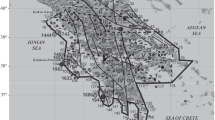Abstract
The article is devoted to earthquake-prone areas recognition with M ≥ 6.0 in the Caucasus and in the Altai–Sayan–Baikal region. A new approach to the classification of intersections of morphostructural lineaments using the definition of a fuzzy set is proposed. The latter enables an integral interpretation of a single result (composition) of high seismicity zones recognition performed by the Barrier-3 and Kora-3 algorithms.




Similar content being viewed by others
REFERENCES
Akopian S.Ts., Bondur V.G., Rogozhin E.A. Technology for monitoring and forecasting strong earthquakes in Russia with the use of the seismic entropy method // Izvestiya, Physics of the Solid Earth. 2017. Vol. 53. Is. 1. P. 32–51. https://doi.org/10.1134/S1069351317010025
Alekseevskaya, M., Gabrielov, A., Gelfand, I., Gvishiani, A., and Rantsman, E., Formal morphostructural zoning of mountain territories, Geophysics, 1977, vol. 42(2), pp. 227–233.
Bongard, M.M., Vaintsvaig, M.N., Guberman, Sh.A., Izvekova, M.L., and Smirnov, M.S., Using a learning software for detection of oil-bearing layers, Geol. Geofiz., 1966, no. 6(II), pp. 15–29.
Dzeboev B.A., Gvishiani A.D., Belov I.O., Agayan S.M., Tatarinov V.N., Barykina Yu.V. Strong Earthquake-Prone Areas Recognition Based on an Algorithm with a Single Pure Training Class: I. Altai-Sayan-Baikal Region, М ≥ 6.0 // Izvestiya, Physics of the Solid Earth. 2019. Vol. 55. Is. 4. P. 563–575. https://doi.org/10.1134/S1069351319040050
Dzeboev, B.A., Soloviev, A.A., Dzeranov, B.V., Karapetyan, J.K., and Sergeeva, N.A., Strong earthquake-prone areas recognition based on the algorithm with a single pure training class. II. Caucasus, M ≥ 6.0. Variable EPA method, Russian Journal of Earth Sciences (RJES), 2019b, vol. 19, ES6005. https://doi.org/10.2205/2019ES000691
Fikhtengolts, G.M., Osnovy matematicheskogo analiza (Principles of Mathematical Analysis), St. Petersburg: Lan, 2015, Parts 1 and 2.
Gabrielov, A.M., Gorshkov, V.I., and Rantsman, E.Ya., An attempt at morphostructural regionalization using formal patterns, in Raspoznavanie i spektralnyi analiz v seismologii (Recognition and Spectral Analysis in Seismology), Vychisl. Seismol. 10, Keilis-Borok, V.I., Ed., 1977, pp. 50–58.
Gelfand, I.M., Guberman, Sh.A., Izvekova, M.L., Keilis-Borok, V.I., and Rantsman, E.Ya., On criteria of high seismicity, Dokl. Akad. Nauk SSSR, 1972, vol. 202, no. 6, pp. 1317−1320.
Gelfand, I.M., Guberman, Sh.A., Keilis-Borok, V.I., Knopoff, L., Press, F., Rantsman, E.Ya., Rotvain, I.M., and Sadovsky, A.M., Conditions for the generation of large earthquakes: California and some other regions, in Issledovanie seismichnosti i modelei Zemli (Studies in Seismicity and Earth Models), Vychisl. Seismol. 9, Keilis-Borok, V.I., Ed., Moscow, 1976, pp. 3–91.
Gorshkov, A. and Novikova, O., Estimating the validity of the recognition results of earthquake-prone areas using the ArcMap, Acta Geophysica, 2018, vol. 66, Iss. 5, pp. 843–853. https://doi.org/10.1007/s11600-018-0177-3
https://ru.wikipedia.org [date of request: October 26, 2020].
Gorshkov A.I., Soloviev A.A., Zharkikh J.I. Recognition of strong earthquake prone areas in the Altai–Sayan–Baikal Region // Doklady Earth Sciences. 2018. Vol. 479. Is. 1. P. 412–414. https://doi.org/10.1134/S1028334X1803025X
Gvishiani, A.D. and Gurvich, V.A., Dinamicheskie zadachi klassifikatsii i vypukloe programmirovanie v prilozheniyakh (Dynamic Classification Problems and Convex Programming in Applications), Moscow: Nauka, 1992.
Gvishiani A.D., Agayan S.M., Dzeboev B.A., Belov I.O. Recognition of Strong Earthquake–Prone Areas with a Single Learning Class // Doklady Earth Sciences. 2017. Vol. 474. Part 1. P. 546–551. https://doi.org/10.1134/S1028334X17050038
Gvishiani A.D., Kaftan V.I., Krasnoperov R.I., Tatarinov V.N., Vavilin E.V. Geoinformatics and Systems Analysis in Geophysics and Geodynamics // Izvestiya, Physics of the Solid Earth. 2019. Vol. 55. Is. 1. P. 33–49. https://doi.org/10.1134/S1069351319010038
Gvishiani A.D., Soloviev A.A., Dzeboev B.A. Problem of Recognition of Strong-Earthquake-Prone Areas: a State-of-the-Art Review // Izvestiya, Physics of the Solid Earth. 2020. Vol. 56. Is. 1. P. 1–23. https://doi.org/10.1134/S1069351320010048
Kosobokov, V.G., Recognition of locations of future large earthquakes in Middle Asia and Anatolia using the Hamming method, Modeli stroeniya Zemli i prognoza zemletryasenii (Models of Earth Structure and Earthquake Prediction), Vychisl. Seismol. 14, Keilis-Borok, V.I., Moscow, 1981, pp. 76–81.
Kosobokov, V.G. and Soloviev, A.A., Pattern recognition in earthquake hazard assessment problems, Chebychev. Sb., 2018, vol. 19, no. 4, pp. 53–88. https://doi.org/10.22405/2226-8383-2018-19-4-55-90
Rantsman, E.Ya., Mesta zemletryasenii i morphostruktura gornykh stran (Earthquake Locations and the Morphostructure of Mountain Countries), Moscow: Nauka, 1979.
Rantsman, E.Ya. and Glasko, M.P., Morfostrukturnye uzly—mesta ekstremalnykh prirodnykh yavlenii (Morphostructural Intersections as Locations of Extreme Natural Phenomena), Moscow: Media-Press, 2004.
Soloviev A.A., Novikova O.V., Gorshkov A.I., Piotrovskaya E.P. Recognition of potential sources of strong earthquakes in the Caucasus region using GIS technologies // Doklady Earth Sciences. 2013. Vol. 450. Is. 2. P. 658–660. https://doi.org/10.1134/S1028334X13060159
Soloviev A.A., Gvishiani A.D., Gorshkov A.I., Dobrovolsky M.N., Novikova O.V. Recognition of earthquake-prone areas: Methodology and analysis of the results // Izvestya, Physics of the Solid Earth. 2014. Vol. 50. Is. 2. P. 151–168. https://doi.org/10.1134/S1069351314020116
Soloviev Al.An., Gorshkov A.I., Soloviev An.Al. Application of the data on the lithospheric magnetic anomalies in the problem of recognizing the earthquake prone areas // Izvestiya, Physics of the Solid Earth. 2016. Vol. 52. Is. 6. P. 803–809. https://doi.org/10.1134/S1069351316050141
Vaintsvaig, M.N., An algorithm for the Kora pattern recognition learning, in Algoritmy obucheniya raspoznavaniyu obrazov (Algorithms for Training of Pattern Recognition), Moscow: Radio, 1973, pp. 8–12.
Zadeh, L.A., Fuzzy sets, Information and Control, 1965, vol. 8, pp. 338–353.
Funding
The study was carried out with the financial support of the Russian Foundation for Basic Research within the framework of the scientific project No. 20-35-70054 “A systematic approach to the integration of recognition algorithms for assessing seismic hazard”.
Author information
Authors and Affiliations
Corresponding author
Rights and permissions
About this article
Cite this article
Gvishiani, A.D., Dzeboev, B.A., Agayan, S.M. et al. Fuzzy Sets of High Seismicity Intersections of Morphostructural Lineaments in the Caucasus and in the Altai–Sayan–Baikal Region. J. Volcanolog. Seismol. 15, 73–79 (2021). https://doi.org/10.1134/S0742046321020032
Received:
Revised:
Accepted:
Published:
Issue Date:
DOI: https://doi.org/10.1134/S0742046321020032




